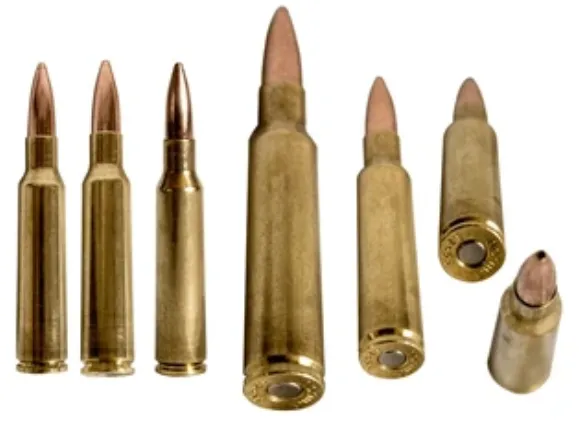
Correct Cartridge Reference: Caliber
The Importance of Accurate Caliber Representation in Firearms: Understanding the Differences Between Designation and Measurement
Definition of Caliber:
In firearms, caliber refers to the nominal internal diameter of the gun barrel, typically measured in inches or millimeters.
In the United States, caliber is usually expressed in either hundredths or thousandths of an inch, depending on the precision. For instance, a "45 caliber" firearm has a barrel diameter of approximately 0.45 inches (which is expressed in hundredths of an inch), while a ".308 caliber" might refer to a diameter of 0.308 inches (expressed in thousandths of an inch).
In the United Kingdom, caliber is typically expressed in thousandths of an inch.
Elsewhere, it’s commonly measured in millimeters, such as a "9 mm pistol," which has a barrel diameter of about 9 millimeters.
Because metric and U.S. customary units don’t convert evenly at this scale, converting calibers between these units often results in approximations rather than exact equivalents.
For rifled barrels (those with spiral grooves inside), caliber measurements can be taken in two ways:
Across the lands (the raised parts between the grooves)
Across the grooves (the cut parts of the rifling)
In the U.S., groove measurements are commonly used in cartridge designations for greater precision, as they reflect the final bore size after machining. Elsewhere, measurements across the lands are more typical.
This distinction is important for understanding how calibers are standardized and labeled in different regions.
Calibers fall into four general categories by size:
Miniature-bore historically refers to calibers with a diameter of 0.22 inch or smaller
Small-bore refers to calibers with a diameter of 0.32 inches or smaller
Medium-bore refers to calibers with a diameter of 0.33 inches to 0.39 inches
Large-bore refers to calibers with a diameter of 0.40 inches or larger
Correct Cartridge Reference: Caliber
There is often confusion when discussing cartridges or firearm chamberings, particularly regarding the accurate representation of caliber. As the use of digital data continues to grow, it's crucial to represent this information correctly to prevent the spread of misinformation. Unfortunately, Wikipedia, and others are misleading many regarding this issue.
Caliber is a designation used to describe the nominal internal diameter of a firearm’s barrel. While it is related to the measurement of inches or millimeters, caliber itself is not a direct measurement. Instead, it is typically expressed in hundredths or thousandths of an inch for imperial systems or in millimeters for metric systems.
For example:
"22 LR" refers to the 22 caliber Long Rifle cartridge, with the caliber "22" representing a nominal diameter of approximately 0.22 inches.
If you were to write ".45 Cal," Using the definition of Caliber, it would incorrectly suggest a diameter of 0.0045 inches, which is not accurate.
It is crucial to stress that the units of measurement are caliber. These measurements are derived from inches or millimeters (mm) however they are not exact measurements of such and should not be designated as such. The current international standard for the metric system is the International System of Units (Système international d'unités or SI), which uses meter, kilogram, and second (MKS). In this system, millimeters are specified as "mm" (lower case), and there is a space between the numerical value and the unit symbol, according to standards. While most markings do not use a space and this has been widely accepted, it is technically improper.
When using metric designations, decimals are only appropriate when the value is not a whole number (e.g., "7.62 mm"). Specifying caliber directly as a measurement of inches and using a leading decimal is entirely incorrect. Caliber should be understood as a unique designation in the firearms industry, separate from precise measurements like inches or millimeters.
For rifled barrels (those with spiral grooves inside), caliber measurements can be taken in two ways:
Across the lands: This measures the distance between the raised parts of the rifling (the lands).
Across the grooves: This measures the distance between the cut parts of the rifling (the grooves).
In the U.S., groove measurements are commonly used in cartridge designations for maximum precision. This is because groove measurements reflect the final bore size after the rifling process, which cuts the grooves into the rough bore, leaving the lands behind.
In other regions, land measurements are more common.
Caliber is a unique designation and not directly interchangeable with inches or millimeters. Caliber should not be confused with exact measurements, and leading decimals should not be used in caliber designations, as they can lead to misinterpretation.
Another important point is that using a leading decimal in caliber designations can create havoc when trying to use search engines. With the value of caliber being incorrect search algorithms, usually lead to incorrect or irrelevant results. This further emphasizes the need to avoid using decimals in caliber representations, as it complicates the retrieval of accurate information.
When specifying exact measurements in drawings, the units of inches (") or millimeters (mm) are commonly used. It is important to distinguish between caliber as a designation and precise measurements, which are often necessary in technical drawings and documentation.
SAAMI (Sporting Arms and Ammunition Manufacturers' Institute) provides the most reliable standards for how calibers should be represented. Misrepresenting caliber by treating it as a direct measurement of inches is incorrect and can lead to confusion.
It is also crucial to understand that finding references that support something incorrect does not validate arguments of incorrect designation. Propagated misunderstanding of the difference between physical dimensions in inches and the correct reference of caliber does not constitute a reliable reference.
Online stores (including this one until it is fixed) often have inconsistencies in how caliber is listed due to varying supplier information, but efforts are being made to standardize these representations.
To summarize: Caliber is a standard designation for firearms that should not be confused with direct measurements of inches or millimeters. It is crucial to use the correct format without leading decimals to ensure clear and accurate communication. Understanding and using the correct unit designation, particularly in an industry as precise as firearms, is vital to avoiding confusion and ensuring accuracy in data representation.

Yowie Outdoors
Blaine, MN 55449

Facebook
Instagram
X
Youtube
TikTok